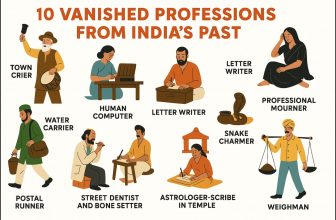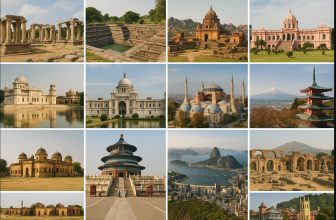India’s history spans thousands of years, with civilizations rising to greatness and then fading into obscurity. Some of the most magnificent ancient cities—once thriving centers of trade, culture, and administration—were lost due to wars, natural disasters, or shifting landscapes. For centuries, these cities remained buried under layers of history, existing only in legends and forgotten records.
However, modern archaeological discoveries have unearthed many of these lost cities, bringing to light advanced urban planning, engineering marvels, and evidence of ancient trade networks. These rediscoveries not only reshape our understanding of India’s past but also challenge historical narratives.
From the submerged remains of Dwarka, the legendary city of Lord Krishna, to the massive Harappan site of Rakhigarhi, India’s ancient cities continue to reveal secrets about the world’s earliest civilizations. In this list, we explore 11 lost Indian cities that were rediscovered in recent times, shedding light on their lost glory and historical significance.
1. Dholavira (Gujarat) – A Harappan Metropolis Rediscovered
Dholavira, one of the most prominent cities of the Indus Valley Civilization (IVC), was discovered in the 1960s and extensively excavated in the 1990s. Unlike other Harappan sites, Dholavira exhibits remarkable town planning with clearly defined zones—citadel, middle town, and lower town.
- Advanced water conservation system with step wells and reservoirs
- Massive city walls built using stone, unlike the usual baked bricks found in Harappan cities
- Intricate street planning indicating a well-organized administration
- UNESCO World Heritage Site status granted in 2021
Dholavira’s rediscovery proved that ancient Indian civilizations had exceptional engineering skills and urban planning that rivaled even the best of their time.
2. Lothal (Gujarat) – The Indus Valley’s Maritime Hub
Lothal, excavated in 1954, stands as one of the most significant port cities of the Indus Valley Civilization. Located near the Gulf of Khambhat, it played a crucial role in maritime trade with Mesopotamia and Persia.
- The world’s earliest known dockyard, designed for ships to enter and exit
- Warehouse structures indicating active trade in beads, gems, and metals
- Advanced drainage systems showcasing superior urban planning
- Evidence of a standardized weight and measurement system, proving its role as a trade hub
Lothal’s excavation revealed that Harappans were not just land-based traders but maritime pioneers who navigated international waters over 4,000 years ago.
3. The Submerged City of Dwarka (Gujarat) – Lord Krishna’s Legendary Kingdom
The city of Dwarka, mentioned in Hindu scriptures, was believed to be mythical until marine archaeology rediscovered its remains off the coast of Gujarat in the early 2000s. Sonar mapping and underwater excavations have revealed the submerged ruins of an ancient city, believed to have been swallowed by the sea thousands of years ago.
- Massive stone structures, roads, and fortifications beneath the sea
- Pottery and artifacts dating back to 1500 BCE
- Coral-encrusted walls, suggesting prolonged submersion
These discoveries fuel ongoing debates about the historicity of the Mahabharata and Krishna’s Dwarka, bringing mythology closer to reality.
4. Hastinapur (Uttar Pradesh) – The Capital of the Kuru Dynasty Unearthed
Mentioned in the Mahabharata as the capital of the Kuru dynasty, Hastinapur was long considered a legendary city. Excavations in the 1950s, led by the Archaeological Survey of India (ASI), uncovered evidence of an ancient settlement that matched descriptions in Hindu texts.
- Painted Grey Ware pottery, consistent with Mahabharata-era artifacts
- Urban planning with multi-room houses
- Fossilized rice grains, suggesting agricultural advancements
This rediscovery supports the theory that Hastinapur was not merely a myth but a real historical city that played a crucial role in early Indian civilization.
5. Sisupalgarh (Odisha) – A Fortified Ancient City That Rivaled Rome
Excavations in the 1940s confirmed that Sisupalgarh was one of India’s earliest urban centers, dating back to 500 BCE. Its well-planned layout, grid-patterned streets, and massive stone walls suggest a sophisticated civilization that flourished even before the Mauryan Empire.
- Massive fortified walls, indicating advanced military defense
- Public structures, roads, and ceremonial platforms
- Well-planned drainage system, a hallmark of early urbanization
Sisupalgarh’s layout was found to be larger than contemporary Rome, proving that ancient India had thriving, well-planned cities even before European urban centers.
6. Keeladi (Tamil Nadu) – A Lost Tamil Civilization Resurfaces
Keeladi, discovered in 2015, is an important Sangam-era settlement dating back to 600 BCE. Unlike the Vedic civilization in the north, Keeladi represents an urban Tamil civilization that was literate, industrialized, and independent.
- Tamil Brahmi inscriptions, proving early literacy
- Well-structured brick houses, indicating an advanced urban settlement
- Gold beads and terracotta objects, suggesting a thriving culture and economy
Keeladi’s findings rewrite history, establishing that South India had a parallel and equally advanced civilization during ancient times.
7. Rakhigarhi (Haryana) – India’s Largest Harappan City
Rakhigarhi, discovered in the 1990s, is the largest Indus Valley site in India, covering over 350 hectares. Excavations revealed a highly developed Harappan settlement with a structured town layout.
- Multi-room houses, streets, and drainage systems
- Burial sites with human remains, offering genetic insights into the Harappan people
- Copper and bronze artifacts, indicating metal craftsmanship
Rakhigarhi challenges earlier assumptions that the Indus Valley Civilization was concentrated in Pakistan, proving that India had equally large Harappan cities.
8. Kalibangan (Rajasthan) – Home to the Oldest Plowed Fields
Excavated in the 1960s, Kalibangan is a Harappan site with unique evidence of agricultural advancements.
- Plowed fields with furrows, making it the oldest known example of farming
- Fire altars, suggesting ritualistic traditions
- Baked brick houses, indicating permanent settlements
Kalibangan proves that the Indus Valley people had mastered agriculture long before other civilizations.
9. Muziris (Kerala) – India’s Ancient Gateway to the Roman Empire
Once a thriving Indo-Roman trade center, Muziris was long lost until excavations at Pattanam in the 2000s confirmed its location.
- Roman amphorae, coins, and beads, proving international trade
- Dockyard remains, suggesting a structured port system
- Sangam-era inscriptions, linking it to Tamil literature
Muziris was one of the world’s oldest trading ports, proving India’s rich maritime history.
10. Adam’s Bridge (Ram Setu) – A Prehistoric Land Connection?
NASA satellite images revealed a chain of limestone shoals between India and Sri Lanka, which some believe to be the Ram Setu from the Ramayana.
- Geological formations that resemble a bridge
- Evidence of land connection existing thousands of years ago
While its origins remain debated, Adam’s Bridge continues to intrigue historians and geologists alike.
11. Kanchanapalli (Andhra Pradesh) – A Forgotten Buddhist Settlement
Recently rediscovered, Kanchanapalli contains Buddhist stupas and rock-cut caves, proving South India’s strong Buddhist heritage.
- Buddhist inscriptions from the Satavahana period
- Stupas and monastic complexes, confirming a Buddhist presence
Kanchanapalli adds to the growing evidence of Buddhism’s deep influence in ancient India.
Final Thoughts – Incredible Archaeological Discoveries of Lost Indian Cities
Many ancient Indian cities, once lost to time, have been rediscovered through modern archaeology. These cities, including Dholavira, Lothal, and Rakhigarhi, belonged to the Indus Valley Civilization and showcased sophisticated urban planning, trade networks, and drainage systems. Other rediscovered cities, like Keeladi and Sisupalgarh, provided evidence of independent, flourishing civilizations outside the Indus Valley.
Submerged cities like Dwarka and long-lost ports like Muziris proved that India’s maritime connections extended as far as Rome and Mesopotamia. Meanwhile, legendary cities like Hastinapur were confirmed to have existed, connecting ancient texts with archaeological evidence.
These rediscoveries prove that India’s history is far older and more complex than previously thought. Each excavation provides a deeper understanding of ancient India’s engineering, governance, and cultural influences, offering fresh perspectives on civilizations that once flourished but were forgotten—until now.





